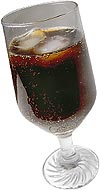Solar + Battery Car DIY STEM Kit
$11.99$5.95
 The extra fizz in a glass full of ice is due to a 'seeding effect.' Although you are
correct that the solubility of CO2 is higher in colder soda, The formation of visible
bubbles is also dependent on the collection of gas molecules together. Due to the
polarity of water and the non-polar nature of CO2 molecules, any nascent bubble will
quickly enlarge as nearby molecules collide and merge with it. The gas molecules are far
less likely to return to the polar aqueous environment surrounding the bubble, as the
attraction between water molecule squeezes the CO2 out from between the water molecules.
So if you can get a bubble started, it will grow to visible size and float to the top.
The extra fizz in a glass full of ice is due to a 'seeding effect.' Although you are
correct that the solubility of CO2 is higher in colder soda, The formation of visible
bubbles is also dependent on the collection of gas molecules together. Due to the
polarity of water and the non-polar nature of CO2 molecules, any nascent bubble will
quickly enlarge as nearby molecules collide and merge with it. The gas molecules are far
less likely to return to the polar aqueous environment surrounding the bubble, as the
attraction between water molecule squeezes the CO2 out from between the water molecules.
So if you can get a bubble started, it will grow to visible size and float to the top.